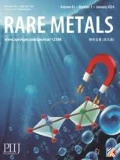Abstract
The microstructure of 2624-T39 aluminum alloy was analyzed by means of metallographic (OM), scanning electron microscope (SEM) and transmission electron microscope (TEM). The effects of different microstructure characteristics on the tensile properties and fatigue crack growth rate of 2624-T39 aluminum alloy were studied. Results showed that the grain size of the alloy was a typical fiber structure along the rolling direction, and the main second phase was the Al2CuMg phase. The grain size of the alloy had an obvious influence on the fatigue crack growth rate, and the alloy showed a lower fatigue crack growth rate due to the larger grain size. The crack initiation zone on the fracture surface of alloys with lower fatigue crack growth rate was relatively rough, the crack propagation zone had obvious fatigue striations, and the transient fracture zone had a large number of smaller dimples.





Similar content being viewed by others
References
Eto T, Nakai M. New process-microstructure method for affordable 2024 series aerospace aluminum alloys. Mater Sci Forum. 2007;539–543:3643.
Dursun T, Soutis C. Recent developments in advanced aircraft aluminium alloys. Mater Des. 2014;56:862.
Heinz A, Haszler A, Keidel C, Moldenhauer S, Benedictus R, Miller WS. Recent development in aluminium alloys for aerospace applications. Mater Sci Eng A. 2000;280(1):102.
Starke EA Jr, Williams JC. Progress in structural materials for aerospace systems. Acta Mater. 2003;51(19):5775.
Srivatsan TS, Kolar D, Magnusen P. The cyclic fatigue and final fracture behavior of aluminum alloy 2524. Mater Des. 2002;23(2):129.
Ge RS, Zhang YA, Li ZH, Wang F, Zhu BH, Xiong BQ. Fatigue crack growth rate and microstructures of 2E12 and 2524 alloy. Chin J Rare Met. 2011;35(4):600.
Tiamiyu AA, Basu R, Odeshi AG, Szpunar JA. Plastic deformation in relation to microstructure and texture evolution in AA 2017-T451 and AA 2624-T351 aluminum alloys under dynamic impact loading. Mater Sci Eng. 2015;636:379.
Thompson AW, Backofen WA. The effect of grain size on fatigue. Acta Metall. 1971;19(7):597.
Zurek AK, James MR, Morris WL. The effect of grain size on fatigue growth of short cracks. Metall Trans A (Phys Metall Mater Sci). 1983;14(8):1697.
Zhang G, Gang L, Ding X, Sun J, Tong Z, Shao Y, Chen K. A fatigue model of high strength Al alloys containing second phase particles of various sizes. Rare Met Mater Eng. 2004;33(1):35.
Saga J, Hayashi M, Nishio Y. Effect of grain size on fatigue crack propagation in aluminium. J Soc Mater Sci Jpn. 1977;26:1202.
Lindigkeit J, Terlinde G, Gysler A, Lütjering G. The effect of grain size on the fatigue crack propagation behavior of age-hardened alloys in inert and corrosive environment. Acta Metall. 1979;27(11):1717.
Carter RD, Lee EW, Starke EA, Beevers CJ. The effect of microstructure and environment on fatigue crack closure of 7475 aluminum alloy. Metall Mater Trans A. 1984;15(3):555.
Shou WB, Yi DQ, Liu HQ, Tang C, Shen FH, Wang B. Effect of grain size on the fatigue crack growth behavior of 2524-T3 aluminum alloy. Arch Civ Mech Eng. 2016;16(3):304.
Yin DY, Liu HQ, Chen YQ, Yi DQ, Wang B, Shen FH, Fu S, Tang C, Pan SP. Effect of grain size on fatigue-crack growth in 2524 aluminium alloy. Int J Fatigue. 2016;84:9.
Valiev RZ, Islamgaliev RK, Alexandrov IV. Bulk nanostructured materials from severe plastic deformation. Prog Mater Sci. 2000;45(2):103.
Plekhov O, Paggi M, Naimark O, Carpinteri A. A dimensional analysis interpretation to grain size and loading frequency dependencies of the Paris and Wohler curves. Int J Fatigue. 2011;33(3):477.
Yang HX, Li JS, Guo T, Wang WY, Kou HC, Wang J. Evolution of microstructure and hardness in a dual-phase Al0.5CoCrFeNi high-entropy alloy with different grain sizes. Rare Met. 2020;39(2):156.
Händel M, Nickel D, Lampke T. Effect of different grain sizes and textures on the corrosion behaviour of aluminum alloy AA6082. Mater Werkst. 2011;42(7):606.
Chen YQ, Pan SP, Zhou MZ, Yi DQ, Xu DZ, Xu YF. Effects of inclusions, grain boundaries and grain orientations on the fatigue crack initiation and propagation behavior of 2524-T3 Al alloy. Mater Sci Eng A. 2013;580:150.
Wang J, Fang C, Hao H, Wang SH, Yang SJ, Dai SL, Zhang XG. Effects of trace Zr on the microstructure and properties of 2E12 alloy. Rare Met. 2009;28(5):511.
Dominguez J, Zapatero J, Pascual J. Effect of load histories on scatter of fatigue crack growth in aluminum alloy 2024-T351. Eng Fract Mech. 1997;56(1):65.
Golestaneh AF, Ali A, Bayat M. Analytical and numerical investigation of fatigue crack growth in aluminum alloy. Key Eng Mater. 2011;462–463(4):1050.
Suresh S. Fatigue crack deflection and fracture surface contact: micromechanical models. Metall Trans A (Phys Metall Mater Sci). 1985;16(1):249.
Cavaliere P. Fatigue properties and crack behavior of ultra-fine and nanocrystalline pure metals. Int J Fatigue. 2009;31(10):1476.
Padilla HA, Boyce BL. A review of fatigue behavior in nanocrystalline metals. Exp Mech. 2010;50(1):5.
Pokluda J. Dislocation-based model of plasticity and roughness-induced crack closure. Int J Fatigue. 2013;46(1):35.
Turnbull A, Rios ERDL. The effect of grain size on fatigue crack growth in an aluminium magnesium alloy. Fatigue Fract Eng Mater Struct. 2010;18(11):1355.
Tan L, Zhang XY, Xia T, Huang GJ, Liu Q. Fracture morphology and crack mechanism in pure polycrystalline magnesium under tension–compression fatigue testing. Rare Met. 2020;39(2):162.
Haigen J, Zhimin Y, Feng J, Xue L. EBSD analysis of fatigue crack growth of 2124 aluminum alloy for aviation. Rare Met Mater Eng. 2014;43(6):1332.
Yamada R, Itoh G, Kurumada A, Nakai M. Further study on the effect of environment on fatigue crack growth behavior of 2000 and 7000 series aluminum alloys. Mater Sci Forum. 2016;879:2153.
Acknowledgements
This work was financially supported by the National Key R&D Program of China (No. 2016YFB0300800).
Author information
Authors and Affiliations
Corresponding author
Rights and permissions
About this article
Cite this article
Huang, G., Li, ZH., Sun, LM. et al. Fatigue crack growth behavior of 2624-T39 aluminum alloy with different grain sizes. Rare Met. 40, 2523–2529 (2021). https://doi.org/10.1007/s12598-020-01496-0
Received:
Revised:
Accepted:
Published:
Issue Date:
DOI: https://doi.org/10.1007/s12598-020-01496-0



